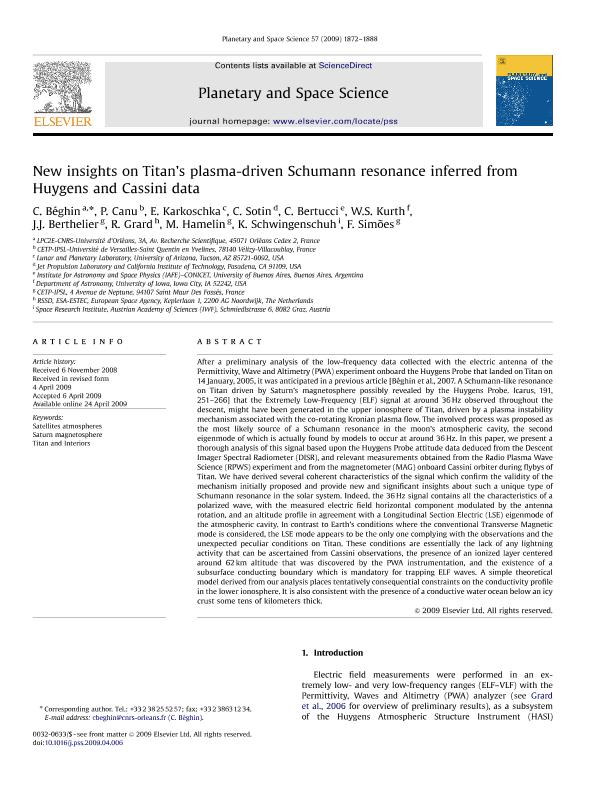Artículo
New insights on Titan's plasma-driven Schumann resonance inferred from Huygens and Cassini data
Béghin, C.; Canu, P.; Karkoschka, E.; Sotin, C.; Bertucci, Cesar ; Kurth, W. S.; Berthelier, J. J.; Grard, R.; Hamelin, M.; Schwingenschuh, K.; Simões, F.
; Kurth, W. S.; Berthelier, J. J.; Grard, R.; Hamelin, M.; Schwingenschuh, K.; Simões, F.
 ; Kurth, W. S.; Berthelier, J. J.; Grard, R.; Hamelin, M.; Schwingenschuh, K.; Simões, F.
; Kurth, W. S.; Berthelier, J. J.; Grard, R.; Hamelin, M.; Schwingenschuh, K.; Simões, F.
Fecha de publicación:
12/2009
Editorial:
Pergamon-Elsevier Science Ltd
Revista:
Planetary and Space Science
ISSN:
0032-0633
Idioma:
Inglés
Tipo de recurso:
Artículo publicado
Clasificación temática:
Resumen
After a preliminary analysis of the low-frequency data collected with the electric antenna of the Permittivity, Wave and Altimetry (PWA) experiment onboard the Huygens Probe that landed on Titan on 14 January, 2005, it was anticipated in a previous article [Béghin et al., 2007. A Schumann-like resonance on Titan driven by Saturn's magnetosphere possibly revealed by the Huygens Probe. Icarus, 191, 251–266] that the Extremely Low-Frequency (ELF) signal at around 36 Hz observed throughout the descent, might have been generated in the upper ionosphere of Titan, driven by a plasma instability mechanism associated with the co-rotating Kronian plasma flow. The involved process was proposed as the most likely source of a Schumann resonance in the moon's atmospheric cavity, the second eigenmode of which is actually found by models to occur at around 36 Hz. In this paper, we present a thorough analysis of this signal based upon the Huygens Probe attitude data deduced from the Descent Imager Spectral Radiometer (DISR), and relevant measurements obtained from the Radio Plasma Wave Science (RPWS) experiment and from the magnetometer (MAG) onboard Cassini orbiter during flybys of Titan. We have derived several coherent characteristics of the signal which confirm the validity of the mechanism initially proposed and provide new and significant insights about such a unique type of Schumann resonance in the solar system. Indeed, the 36 Hz signal contains all the characteristics of a polarized wave, with the measured electric field horizontal component modulated by the antenna rotation, and an altitude profile in agreement with a Longitudinal Section Electric (LSE) eigenmode of the atmospheric cavity. In contrast to Earth's conditions where the conventional Transverse Magnetic mode is considered, the LSE mode appears to be the only one complying with the observations and the unexpected peculiar conditions on Titan. These conditions are essentially the lack of any lightning activity that can be ascertained from Cassini observations, the presence of an ionized layer centered around 62 km altitude that was discovered by the PWA instrumentation, and the existence of a subsurface conducting boundary which is mandatory for trapping ELF waves. A simple theoretical model derived from our analysis places tentatively consequential constraints on the conductivity profile in the lower ionosphere. It is also consistent with the presence of a conductive water ocean below an icy crust some tens of kilometers thick.
Palabras clave:
Satellites Atmospheres
,
Saturn Magnetosphere
,
Titan And Interiors
Archivos asociados
Licencia
Identificadores
Colecciones
Articulos(IAFE)
Articulos de INST.DE ASTRONOMIA Y FISICA DEL ESPACIO(I)
Articulos de INST.DE ASTRONOMIA Y FISICA DEL ESPACIO(I)
Citación
Béghin, C.; Canu, P.; Karkoschka, E.; Sotin, C.; Bertucci, Cesar; et al.; New insights on Titan's plasma-driven Schumann resonance inferred from Huygens and Cassini data; Pergamon-Elsevier Science Ltd; Planetary and Space Science; 57; 14-15; 12-2009; 1872-1888
Compartir
Altmétricas



